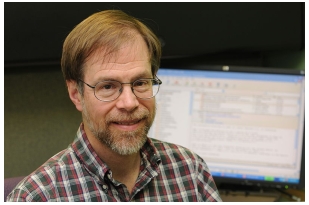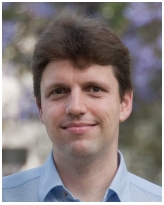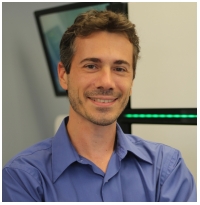Invited Speakers
James Demmel

Professor, Department of Mathematics, Computer Science Division, University of California, Berkeley
Communication-Avoiding Algorithms for Linear Algebra and Beyond
Algorithms have two costs: arithmetic and communication; i.e. moving data between levels of a memory hierarchy or processors over a network. Communication costs, measured in time or energy per operation, already greatly exceed arithmetic costs, and the gap is growing over time following technological trends. Therefore our goal is to design algorithms that minimize communication. We present algorithms that attain provable lower bounds on communication, and show large speedups compared to their conventional counterparts. These algorithms are for direct and iterative linear algebra, for dense and sparse matrices, as well as direct n-body simulations. Several of these algorithms exhibit perfect strong scaling in both time and energy: run time for a fixed problem size drops proportionally to number of processors p, while the energy used remains constant. Finally, we describe extensions to algorithms involving very general loop nests and array accesses, in a way that could be incorporated into compilers.
James Demmel is the Dr. Richard Carl Dehmel Distinguished Professor of Computer Science and Mathematics at University of California, Berkeley. His personal research interests are in numerical linear algebra, high performance computing, and communication-avoiding algorithms in particular. He is known for his work on the LAPACK and ScaLAPACK linear algebra libraries. He is a member of National Academy of Sciences, National Academy of Engineering; a Fellow of ACM, AMS, IEEE, and SIAM; and winner of IPDPS Charles Babbage Award, IEEE Computer Society Sidney Fernbach Award, SIAM J. H. Wilkinson Prize in Numerical Analysis and Scientific Computing, and numerous best paper prizes. He was an invited speaker at 2002 International Congress of Mathematicians and 2003 International Congress on Industrial and Applied Mathematics.
Anil K. Goel

Vice President and Chief Architect, HANA, SAP
SAP HANA: Enterprise Data Management Meets High Performance Computing
SAP's HANA data management platform was architected from the ground up in order to leverage modern hardware technologies, including large main memories, multi-core parallelism, SIMD architectures and vector processing, and to exploit software/hardware co-innovation. HANA supports novel and existing applications with dramatically faster queries, access to up-to-date business data, and greatly simplified database administration. This presentation will outline the technology trends which convinced SAP to build a leading edge database system designed to support enterprise applications. Some of the key aspects of the internal design of the HANA system will be described, explaining how it achieves orders of magnitude performance improvements. We will also reflect upon some of the future directions for HANA to stay abreast of imminent advancements in storage class memories and system architectures.
Anil K. Goel is Vice President and Chief Architect at SAP, where he works with the globally distributed HANA platform engineering team to drive forward looking architectures, vision, strategy, and execution for all SAP data management products and technologies. He oversees data platform related co-innovation projects with hardware and software partners as well as collaborative research and internship programs with many universities in North America and Europe. His interests include database system architecture, in-memory and large scale distributed computing, self-management of software systems and cost modelling. Anil earned a Ph.D. in Computer Science from University of Waterloo, M.Tech. in Computer Science from Indian Institute of Technology Delhi, and B.E. in Electronics and Communications Engineering from University of Delhi.
Harald Pfeiffer

Assistant Professor, Canadian Institute for Theoretical Astrophysics, University of Toronto
Binary Black Hole Coalescence
Black holes are the most compact objects possible within the theory of general relativity. Their gravitational fields are so strong that they deform the causal structure of space-time itself, so that neither matter nor light can escape from the region inside a black hole's event horizon. The numerical study of black holes has been an area of intense effort for many decades, with particular attention on the collision of two black holes. This talk briefly introduces black holes and explains why accurate simulations of colliding black holes are needed for gravitational wave observatories. I will describe how general relativity can be rewritten as partial differential equations, and outline some of the challenges encountered in the process of simulating these on supercomputers. This will touch on topics like multi-domain pseudo-spectral methods for elliptic and hyperbolic problems, constraint-preserving boundary conditions, and control system theory. I will close with some recent numerical results.
Harald Pfeiffer obtained a Ph.D. from Cornell University in 2003. After postdoctoral research at California Institute of Technology, he joined Canadian Institute for Theoretical Astrophysics at University of Toronto in 2009. He uses supercomputer calculations to learn about black holes and Einstein's theory of general relativity, and works on using gravitational wave telescopes to find gravitational waves, and to decipher what these waves tell us about black holes, the behavior of gravity in extreme circumstances, and our universe. Professor Pfeiffer is Canada Research Chair in Numerical Relativity and Gravitational Wave Astrophysics. He is a Fellow of Canadian Institute of Advanced Research and has received an Ontario Early Researcher Award.
Aristotelis Tsirigos

Associate Professor, Department of Pathology, School of Medicine, New York University
Characterization of Aberrant Epigenetic Patterns in T Cell Leukemia
T-cell acute lymphoblastic leukemia (T-ALL) is a hematological malignancy with a dismal overall prognosis, including a relapse rate of up to 25%, mainly because of the lack of non-cytotoxic targeted therapy options. In collaboration with Ioannis Aifantis' lab at the New York University Langone Medical Center, we studied epigenetic mechanisms that transform T cells and cause leukemia. Using the New York University's high-performance computing infrastructure, we processed billions of reads from second-generation sequencing experiments, performed extensive quality control and computational validation before analyzing and integrating the different types of data. Management of sequencing data is a challenging task in terms of storage, computation and data retention. Therefore, we devised simple strategies to improve efficiency, turnover and incremental analysis in our computational pipelines built on top of our GenomicTools platform. Extensive high-throughput sequencing of samples obtained from mouse models, cell lines or patients and subsequent analyses helped reveal the role of histone modifications and their epigenetic modulators. More specifically, we first identified aberrant histone 3 lysine 27 (H3K27) methylation patterns and demonstrated that the histone K27 methyl-transferase EZH2 is a tumor suppressor in T cell acute lymphoblastic leukemia. Next, we delineated the role of the H3K27 demethylases JMJD3 and UTX in T-ALL. We showed that JMJD3 is essential for the initiation and maintenance of T-ALL, as it controls important oncogenic gene targets by modulating H3K27 methylation. By contrast, we found that UTX functions as a tumor suppressor and is frequently genetically inactivated in T-ALL. Moreover, we demonstrated that the small molecule inhibitor GSKJ4 affects T-ALL growth, by targeting JMJD3 activity. Collectively, these findings show that two proteins with a similar enzymatic function can have opposing roles in the context of the same disease, paving the way for treating hematopoietic malignancies with a new category of epigenetic inhibitors.
Aristotelis Tsirigos is an Associate Professor of pathology at New York University School of Medicine. He received his Ph.D. in Computer Science from Courant Institute of Mathematical Sciences at New York University in January 2006, and his B.Sc. from the National Technical University of Athens in 1998. Dr. Tsirigos' research focus is primarily in computational genomics and involves the design of statistical/computational methods and pipelines to model biological systems and generate novel biological hypotheses. Dr. Tsirigos is a member of Molecular Pathology Laboratory, Genome Technology Center, and is affiliated with Center of Health Informatics and Bioinformatics.